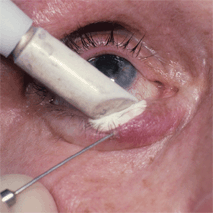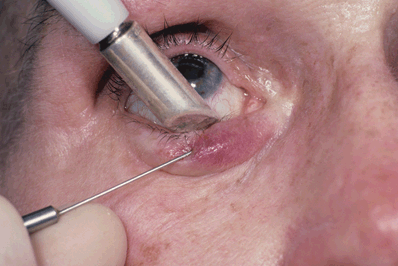5 Cryotherapy

Clinical research evaluating cryotherapy of benign and malignant eyelid tumors produced an unexpected side effect—the loss of eyelashes in the treated area. Follow-up studies confirmed its usefulness, and cryotherapy became a standard of treatment for aberrant eyelashes.
Trichiasis is a misdirection or inturning of previously normally placed eyelashes, allowing abrasions of the globe. Congenital distichiasis represents a local or diffuse growth of an extra row of lashes from the multipotential tarsal meibomian glands. Metaplasia of previously normal meibomian glands may occur as an acquired condition secondary to trauma or chronic inflammation.
MASQUERADE
Aberrant lashes should be distinguished from eyelid malpositions that result in secondary inturning of normal lashes. Skin folds seen in severe dermatochalasis, epiblepharon, and in epicanthus varieties mechanically push normally positioned lashes toward the globe. Entropion is an inturning of the entire lid margin and lashes. Although involutional entropion is usually easily diagnosed, cicatricial entropion secondary to trauma or conjunctival shrinkage disorders may be difficult to distinguish from trichiasis or distichiasis. The presence of symblepharon and metaplasia of the lid margin and meibomian glands with acquired distichiasis blurs its distinction from cicatricial entropion, and multiple therapeutic approaches may be necessary.
INDICATIONS FOR TREATMENT
The patient with trichiasis or distichiasis often seeks treatment because of ocular discomfort, redness, and foreign body sensation owing to corneal and conjunctival abrasions. Chronic irritation of the cornea may lead to localized thinning or vascularization, with risk of subsequent ulceration or perforation.
MECHANISM OF CRYODESTRUCTION
A double freeze-thaw method with thermocouple monitoring of tissue temperature if available to −20°C has been most effective in the treatment of aberrant lashes. Two cycles of rapid freezing with iceball formation, followed by a slow thaw, induce destruction of the thermally sensitive lash follicles, while allowing recovery of the relatively resistant conjunctiva, tarsus, skin, and lacrimal outflow apparatus. Multiple factors contribute to the effect, including intracellular ice crystal formation and recrystallization, disruption of intracellular membranes and cell walls, intracellular pH changes, vascular thrombosis, and a posttreatment inflammatory response.
SURGICAL ANATOMY
The normal eyelashes arise in the anterior lamella of the eyelid and consist of a few irregular rows exiting the skin anterior to the intermarginal sulcus. The normal follicles lie in the pretarsal space near the marginal arterial arcade. The meibomian sebaceous glands are located in the fibrous tarsus and their orifices are located in the posterior lamella (i.e., posterior to the intermarginal sulcus) (see Chapter 1). Lack of differentiation of these glands during development may be accompanied by association of the glands with lash follicles.
ALTERNATIVE THERAPIES
Frequent mechanical epilation along with use of topical lubricants is preferred by some patients. The use of contact lenses is of limited value to protect the cornea. Electrolysis can be used to destroy isolated small numbers of lashes. Placement of the needle is difficult and results in a relatively high recurrence rate. Localized lid scarring can also be produced. Argon laser ablation at the slit lamp can also be used for individual lashes, but this has similar limitations.
Microscopic surgical excision of individual follicles is tedious and difficult. Lid splitting combined with cryotherapy may be useful in certain cases of congenital distichiasis. Surgical excision of a localized full-thickness section of eyelid can be utilized for small to moderate areas of lashes. Marginal rotation procedures can direct the entire lid margin away from the globe (see Chapter 6). A combination of surgical treatment, systemic medical therapy, and cryotherapy may be indicated in conjunctival shrinkage disorders.
OTHER USES OF CRYOTHERAPY
Cryotherapy has been employed with variable success for benign and malignant tumors of the eyelid and ocular adnexa. It has proved very effective in the treatment of epithelial and pigmented malignancies of the conjunctiva. Cryotherapy combined with surgical excision and topical mitomycin has become an acceptable alternative to exenteration in many patients, in an attempt to preserve a useful eye. This is especially true in the monocular or otherwise ophthalmically compromised patient, or in those who refuse or cannot undergo more extensive treatment.
The addition of cryotherapy and mitomycin to simple excision of conjunctival intraepithelial dysplastic lesions and squamous cell carcinoma has decreased the recurrence rate and improved the long-term prognosis. This combination has become the treatment of choice in cases without intraocular and intraorbital invasion and allows the treatment of large areas with relatively minimal destruction of normal tissue. It also can be used in selected patients who have localized scleral invasion of epithelial malignancies, often combined with an amniotic membrane graft.
Malignant melanomas of the conjunctiva usually begin as radial intraepithelial proliferations of atypical melanocytes, followed by an invasive nodular progression. Radical surgical exenteration had been the treatment of choice but does not prevent metastatic disease. Although radical surgery is still sometimes considered necessary for lesions with a deep invasive component, cryotherapy combined with localized excision of nodules and mitomycin has become an important treatment modality.
Melanocytes are selectively sensitive to freezing. Cryotherapy is optimal for flat, noninvasive intraepithelial disease before nodule growth is present. Freezing large areas of acquired melanosis is preferable to huge conjunctival excisions with resultant symblepharon formation and globe limitations. Surgical excision of localized nodular disease combined with cryotherapy to the underlying excision bed and to the surrounding areas of flat pigmentation allows sloughing of the treated epithelium, while sparing the substantia propria, which acts as a framework for reepithelialization. Extensive areas of flat pigmentation can be treated serially in the office. Although some migration of adjacent pigmented cells may occur in treated areas, the overall number of cells is greatly reduced and prognosis is dramatically improved. Posttreatment biopsies, especially in pigmented areas, will distinguish between tumor recurrence and melanin accumulation in macrophages. Recurrences can be managed by repeat cryotherapy or more radical surgery.
PROCEDURE
Topical anesthesia is applied, and 2% lidocaine with epinephrine is infiltrated subcutaneously in the lid. Epinephrine facilitates rapid freezing and slow thawing by vasoconstriction. A handheld cryoapplication unit is used, and the tissue temperature is monitored by a thermocouple probe.

Figure 5-1. A thermocouple 23-gauge probe is placed in the pretarsal space, at the base of the lash follicles. The tip of the cryoprobe is placed adjacent to the tip of conjunctival surface of the lid margin in a position perpendicular to the lid and, thus, parallel to the hair shaft. The globe can be protected with a scleral shell if desired.
Stay updated, free articles. Join our Telegram channel

Full access? Get Clinical Tree


